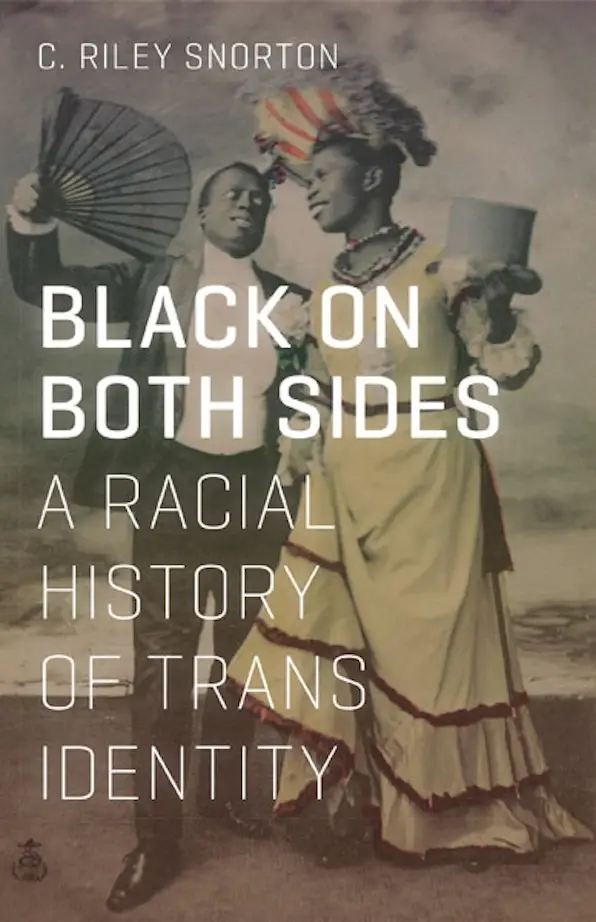We’re thrilled to continue our Trans Bookworm Series, a dedicated space on the Plume blog where we delve into stories, ideas, and experiences written by and about trans people.
This series celebrates the richness of trans lives, exploring everything from memoirs to poetry to critical theories. Each featured book invites us to reflect on the diversity of trans perspectives and the transformative power of representation.
Each month, we spotlight a new book, breaking down its key ideas and discussing why it matters to our community. Whether you’re a seasoned reader or just starting to explore trans literature, this series is for you—a place to learn, connect, and grow.
Together, we celebrate the voices that illuminate our stories and offer deeper insights into the world we live in.
This month, in honor of Black History Month, we’re spotlighting Black on Both Sides: A Racial History of Trans Identity by C. Riley Snorton.
In this groundbreaking book, Snorton bridges the histories of Blackness and transness, uncovering how shared experiences of oppression, resistance, and survival have shaped these identities.
Through powerful analysis and storytelling, Black on Both Sides redefines how we think about identity, history, and liberation.
Let’s dive into its key themes and ideas to see why this text is so impactful.

Table of Contents
Ungendered Flesh and the Science of Sex
Imagine being treated as less than human—just a body to be used for someone else’s gain. That’s what Snorton dives into here, focusing on the horrific ways enslaved Black women’s bodies were used as tools in the development of gynecology. J. Marion Sims, a man often called the “father of modern gynecology,” experimented on enslaved women like Anarcha, Betsey, and Lucy without anesthesia. Why? Because the racist belief at the time was that Black people didn’t feel pain the way white people did.
Snorton uses the term ungendered flesh, borrowing from scholar Hortense Spillers, to explain how slavery erased individuality and traditional ideas of gender for Black people. Enslaved women weren’t seen as women in the way white women were; instead, they were reduced to “flesh”—commodities to be worked, bred, and experimented on. This erasure of humanity laid the groundwork for racist stereotypes we still see today, like the idea that Black women are inherently strong and don’t need as much care or compassion.
Why It Matters:
This history isn’t just about the past—it’s about right now. Black women today still face disparities in healthcare, often being dismissed or underestimated by medical professionals. Think about the Serena Williams story: even as one of the most famous athletes in the world, her life-threatening postpartum complications were initially ignored by doctors. By understanding this history, we can start to dismantle the systemic racism that’s been built into our healthcare systems and ensure everyone gets the care they deserve.
Trans Capable: Fungibility and Fugitivity
Let’s break down two key ideas here: fungibility and fugitivity. Fungibility is the idea that something—or someone—is interchangeable, like a dollar bill. During slavery, enslaved people were treated as commodities, completely replaceable and without individual value.
But fugitivity flips that script. It’s about resistance and escape, about reclaiming agency in a system designed to strip it away. Snorton highlights stories of enslaved people who cross-dressed to escape bondage. For example, Ellen Craft disguised herself as a white male plantation owner to flee the South with her husband. These acts weren’t just about survival; they disrupted the rigid ideas of race and gender that propped up slavery.
Snorton argues that this connection between race and gender fluidity is deeply rooted in history. Enslaved people had to navigate systems that didn’t see them as fully human, and they used every tool available—including the fluidity of their identities—to carve out paths to freedom.
Why It Matters:
This isn’t just an interesting historical tidbit—it’s a reminder that trans and non-binary identities aren’t “new.” For Black people, especially Black trans folks, this history shows a legacy of resilience and ingenuity. It also challenges us to think about gender and race not as fixed categories but as things that have always been fluid and shaped by survival.
Reading the “Trans-” in Transatlantic Literature
The word “trans” often makes people think of gender, but Snorton asks us to see it in a broader sense. Take the transatlantic slave trade, for example. The “trans” here speaks to movement—forced across oceans, identities, and humanity itself. For enslaved people, this wasn’t just a physical transition; it was a stripping away of everything they knew, leaving them in a state of constant in-betweenness.
Snorton connects this to W.E.B. Du Bois’s idea of “double consciousness,” where Black people are forced to see themselves both through their own eyes and the lens of a racist society. It’s a constant juggling act, existing in two worlds at once. Snorton extends this to gender, showing how enslaved people lived in a perpetual state of imposed transition—not fully human, not fully male or female, but something else entirely.
Why It Matters:
This chapter pushes us to rethink how we talk about identity. It’s not just about personal labels or categories—it’s about survival and how systems of oppression force people into states of flux. For Black trans people, this history validates their experiences and places them within a broader story of resilience and resistance.
A Nightmarish Silhouette: Racialization and Transition
Ever notice how certain stories get amplified while others are ignored? That’s what Snorton explores here. He compares Christine Jorgensen, a white trans woman who became a media darling in the 1950s, to Black trans figures like Lucy Hicks Anderson, whose stories were largely erased or criminalized.
Jorgensen’s rise to fame was framed as a story of progress and possibility, but only for people who fit a very narrow mold: white, middle-class, and gender-conforming in their transness. Meanwhile, Black trans people like Anderson were treated as threats to the social order. Snorton ties this to broader systems of imperialism and domestic racism, showing how Black and trans bodies were—and are—policed in ways that intersect and compound each other.
Why It Matters:
This isn’t just about history—it’s about who gets to be seen and heard today. Trans movements that center on whiteness perpetuate the erasure of Black trans people and their struggles. By reclaiming these stories, we can build a more inclusive and equitable movement that acknowledges the unique challenges faced by trans people of color.
DeVine’s Cut: Public Memory and the Politics of Martyrdom
In 1993, three people were murdered in Humboldt, Nebraska: Brandon Teena, Lisa Lambert, and Phillip DeVine. Most people know Brandon’s story because of the movie Boys Don’t Cry, but Phillip DeVine, a Black disabled man, is often left out of the narrative.
Snorton argues that this erasure is part of a pattern he calls “murderous inclusion,” where only specific lives are deemed worthy of remembrance. DeVine’s death is framed as incidental, a tragic backdrop to Brandon’s story, rather than a systemic issue rooted in anti-Black and anti-trans violence.
Why It Matters:
Who we remember—and how we remember them—shapes our understanding of justice. By centering Phillip DeVine, we honor the full complexity of this tragedy and challenge the selective way society grieves. It’s a call to action for intersectional advocacy that doesn’t leave anyone behind.
Snorton wraps up by showing that Blackness and transness aren’t separate—they’re deeply connected, shaped by shared histories of dehumanization and survival. Both are about movement, fluidity, and the ability to transform in the face of oppression. This perspective invites us to rethink identity and oppression. Instead of seeing race and gender as separate struggles, Snorton shows how they overlap and inform each other. For activists and allies, this means fighting for justice in a truly inclusive and transformative way.
We hope this book inspires you as much as it inspired us. Stay tuned for next month’s spotlight in the Trans Bookworm Series, where we’ll continue to explore the transformative power of trans literature.



